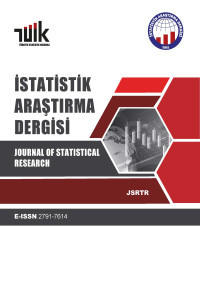Gıda Tüketim Analizi: Genişletilmiş Doğrusal Harcama Sistemi
Hanehalkı bütçe anketinden elde edilen tüketim harcamaları bilgileri ile; tüketici fiyat endekslerinde kullanılacak maddelerin seçimi ve temel yıl ağırlıklarının elde edilmesi, hanelerin tüketim kalıplarında zaman içinde meydana gelen değişikliklerin izlenmesi, milli gelir hesaplamalarında özel nihai tüketim harcamaları tahminlerine yardımcı olacak verilerin derlenmesi, yoksulluk sınırının belirlenmesi, asgari ücret tespit çalışmaları, vb. diğer sosyo-ekonomik analizler için gerekli verilerin elde edilmesi amaçlanmaktadır. Bu çalışmada, Türkiye İstatistik Kurumu 2003 yılı Hanehalkı Gelir ve Tüketim Harcamaları anket verileri kullanılmıştır. Gıda alt grupları harcaması için marjinal bütçe payı ve gelir esnekliği, genelleştirilmiş doğrusal harcama sistemi yaklaşımı çerçevesinde tahmin edilmiştir. Elde edilen bulgulara göre, hanehalkı tüketici davranışı analiz edilmektedir.
Anahtar Kelimeler:
Genelleştirilmiş doğrusal harcama sistemi, Marjinal bütçe payı, Gelir esnekliği
Food Consumption Analysis: An Extended Linear Expenditure System
With information about consumption expenditures obtained from Household Budget Survey it is aimed to determine the items to be included in consumer price indices and the base year weights; to monitor the changes of households’ consumption patterns within the time; to compile the data which will help in forecasting private final consumption expenditures used in the national income calculation; to obtain required data for the determination of poverty line and other socio-economic analysis; to obtain necessary information to enable the minimum wage to be determined according to recent conditions. In this study, data of the household income and consumption expenditure surveys conducted by the Turkish Statistical Institute for 2003 year is used. Marginal budget share and income elasticity for food sub groups expenditure are estimated within the framework of the extended linear expenditure system. According to the findings obtained, household consumer behavior is analyzed.
___
- Burney, N. A., Akmal, M., 1991. Food demand in Pakistan: An application of the extended linear expenditure system. Journal of Agricultural Economics, 42(2):185-95.
- Deaton, A., Castillo, J. R., Thomas, D., 1989. The influence of household composition on household expenditure patterns: Theory and Spanish evidence. The Journal of Political Economy, 97: 179-200.
- Eastwood, D. B., Craven, J. A., 1981. Food demand and savings in a complete, extended, linear expenditure system. American Agricultural Economics Association, 63(3): 544-549.
- Ekinci, S., 1996. Türkiye’de bazı gıda maddelerinin talep analizi. Çukurova Üniversitesi (Yüksek Lisans Tezi), 65.
- Howe, H., 1977. Cross-section application of linear expenditure systems: Responses to sociodemographic effects. American Journal of Agricultural Economics, 59(1):141-148.
- Huang, J., Bouis, H., 2001. Structural changes in the demand for food in Asia: Empirical evidence from Taiwan. Agricultural Economics, 26:57-69.
- Koç, A., 1995. Türkiye’de kırmızı et arz ve talebinin ekonometrik analizi ve kırmızı et sanayi yapısı ile işleyişinin incelenmesi. Çukurova Üniversitesi (Doktora Tezi).
- Lee, J., Brown, M. G., Seale, J. L., 1994. Model choice in consumer analysis: Taiwan, 1970-89. American Journal of Agricultural Economics, 76(3):504-512
- Lewis, P., Andrews, N., 1989. Household demand in China. Applied Economics, 21(6):793-807.
- Lluch, C., Williams, R., 1975. Cross country demand and savings patterns: An application of the extended linear expenditure system. The Review of Economics and Statistics, 57(3):320-328.
- Lluch, C., 1973. The extended linear expenditure system. European Economic Review, 4(1):21-32.
- Mcconnell, K., 1978. Estimating and testing a complete system of demand functions from regional data. Applied Economics, 10(2):93-104.
- Narayana, N. S. S., Vani, B. P., 1996. Earnings and consumption by Indian rural laborers: Analysis with an extended linear expenditure system. Journal of Policy Modeling, 22(2):255-273.
- Nişancı, M., 2002. Kırsal ve kentsel kesimlerde tüketim ve tasarruf kalıpları genişletilmiş doğrusal harcama sistemi uygulaması. İktisadi ve İdari Bilimler Dergisi, 16(3):60-73.
- Özer, H., 1992. Erzurum’da tüketim harcamalarının ekonometrik analizi. Erzurum: Atatürk Üniversitesi Sosyal Bilimler Enstitüsü (Yayınlanmamış Yüksek Lisans Tezi).
- Özer, H., 2001. Türkiye’de hanehalkı tüketim harcamalarının doğrusal harcama sistemi yaklaşımıyla analizi.
- Philips, L., 1972. A dynamic version of the linear expenditure model. The Review of Economics and Statistics, 54(4):450-458.
- Pollak, R. A., Wales, T. J., 1969. Estimation of the linear expenditure system. Econometrica, 37(4):611-628.
- Sas, 2004. Sas enterprise guide. Sas Institute Inc., Cary, NC, USA.
- Sasaki, K., Saegusa Y., 1974. Food demand matrix in an approximate linear expenditure system. American Journal of Agricultural Economics, 56(2):263-270.
- Stone, R., 1954. Linear expenditure systems and demand analysis: An application to the pattern of British demand. The Economic Journal, 64:511-527.
- Tansel, A., 1986. An engel curve analysis of household expenditure in Turkey. METU Studies in Development, 239-257.
- Türkiye İstatistik Kurumu, 2008. http://www.turkstat.gov.tr/MetaVeri.do?tb_id=22&ust_id=7, 27 Kasım 2008.
- ISSN: 1303-6319
- Başlangıç: 2002
- Yayıncı: TÜİK
Sayıdaki Diğer Makaleler
Bulanık Sistem Modellerinin Gelişimi
Sağa Çarpık Dağılım Ortalamaları için Bazı Testlerin Kullanımı ve Karşılaştırmaları
Emre Erçin SARISOY, Hamza GAMGAM
Gıda Tüketim Analizi: Genişletilmiş Doğrusal Harcama Sistemi
Mehmet Arif ŞAHİNLİ, Ahmet ÖZÇELİK
Türkiye’deki İllerin Sosyo-Kültürel Gelişmişlik Derecelerine Göre Değerlendirilmesi
Esin FİRUZAN, Yusuf Yüksel AYVAZ, Ersen UZUN
Doğrudan ve Dolaylı Mevsim Düzeltme Yaklaşımları: GSYİH Serileri için Bir Uygulama
Özlem YİĞİT, Bedriye SARAÇOĞLU
